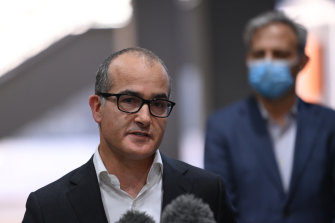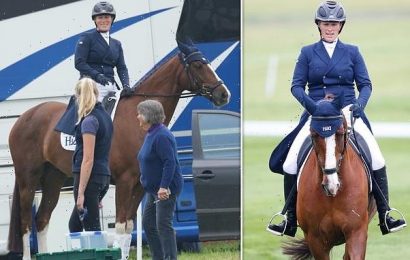For our free coronavirus pandemic coverage, learn more here.
So lockdown continues. We nearly have this outbreak under control, but are just not quite there yet.
The latest six cases announced on Wednesday captured both good and bad news. One new case has been in quarantine for their entire infectious period with no new exposure sites to add – that’s the best news. Another case moved between an exposure site in Brighton and their home in Anglesea, raising some alarm bells. A Victorian family holidayed over the border in NSW before being tested, and both parents and their two children tested positive yesterday.
Acting Premier James Merlino has announced an extension of Melbourne’s seven-day lockdown.Credit:Eddie Jim
One case in this family was reported to have been tested six days after symptoms began on 25 May. This is not such good news. Public heath teams must now work backwards, and across borders to see if there are other potential chains of transmission to follow up.
Lockdown is still needed, unfortunately, and we need to be sure that all people who should be in quarantine are safely there before we open up.
Almost as alarming as the talk of a longer lockdown this week was the news of “fleeting meeting” or “stranger to stranger” transmission. The contact tracing commander, Jeroen Weimar, did refer to transmission via “brushing shoulders” in Tuesday’s press conference, and said we had not seen this before. But what was not reported was that we did not have this level of granular detail in 2020, so it is hard to compare.
During the second wave, we barely had exposure venue notifications up and running and, even though in lockdown for most of it, the lack of any check-in information made contact tracing that much harder. Of course, our contact tracing and testing capacity is also markedly improved now. In fact the visibility of more casual contact transmission is actually a mark of our high testing numbers and stronger contact tracing and detective work.
I also take heart at the news that all but the most recent cases can be linked to other known cases or exposure sites, with all but two links worked out. Those two do have overlap in geography and time with exposure sites and, even if the exact locations are never identified, we are in a better position than ever before to understand how this virus moves amongst us. We might not like what we see, but better the devil we know.
The initial missing link case who passed the virus from the initial returned traveller to the cases discovered over this last week may also never found, but the rest of this outbreak has been mapped to an extraordinary level of detail. Similar transmission likely did happen in 2020, we just couldn’t see it, and these cases were either missed altogether, or buried among the 18 per cent of cases labelled “mystery cases”.
We are in a very different position now to understand the nature and extent of the chains of transmission, and that changes in our public health responses as we learn more about our transmission weak points. We are seeing spread associated with venues where we have not required check-in previously. This changes now. All sites that have been identified in the more casual exposure sites, including smaller retail stores, grocery stores and display homes, I am sure will now be required to have check-in to support contact tracing.
People pottering in local grocery stores, browsing phones in a Telstra shop or visiting a display home have now been recognised for the risk they pose. Being indoors with a case who is infectious is a risk. The Port Melbourne resident who became a case may have been in a coffee shop frequented by workers from the Stratton Finance group, where more than one infectious worker might also have been queuing for a takeaway coffee. You don’t check-in because it’s takeaway, but you might be waiting five minutes for your coffee next to a case or two – that’s all it takes to get infected.
Chief Health Officer Brett Sutton also explained there was suspicion that one case had acquired their infection by being in a closed indoor space a case had also been in a couple of hours earlier. That’s more of a worry if it proves true as this is characteristic of aerosol spread.
But this is one in 60 cases and thankfully rare. But we do have to learn that we may need to lengthen exposure times listed to include a period after a case leaves in settings where there is little air movement.
Tweaking our exposure site list, asking people to come forward to test once we extend opening times at some venues, asking people who tested negative after being at certain Tier 2 sites to now test again and quarantine for 14 days, all takes time. So too does chasing up these latest cases who are not in quarantine. But this is manageable and we are tantalisingly close to the leading edge of this outbreak, so we must grin and bear another week and see this battle to the end.
We are now up to at least 10 generations of spread in this outbreak with the virus running unchecked for the first three weeks. This lockdown extension is still about getting everyone into quarantine who needs to be before we can open up, not using the lockdown itself to kill off the virus, but letting our contact tracers continue to do their thing. We don’t have to have zero new cases to open up, we just need them to all have been in quarantine while infectious.
Professor Catherine Bennett is chair in epidemiology at Deakin University’s School of Health and Social Development.
Most Viewed in Politics
From our partners
Source: Read Full Article








